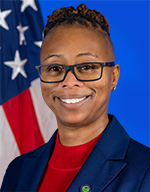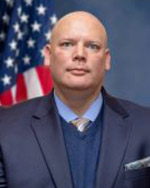LaKisha A. Price

LaKisha Price currently serves as the Acting Vice President of System Operations Services within the Air Traffic Organization (ATO).

LaKisha Price currently serves as the Acting Vice President of System Operations Services within the Air Traffic Organization (ATO).

Dale McNeal, Vice President (A), Safety and Technical Training (AJI-0) in the Air Traffic Organization (ATO), oversees the ATO’s Safety Management System, the analysis of safety data and quality reporting, the identification of safety trends affecting service quality, and the investigation and independent validation and verification of safety issues through the work of the four AJI directorates.
Prior to his current position, Dale served as the Deputy Vice President (DVP), Air Traffic Services (AJT-0). As the DVP, he was responsible for all aspects of air navigation services and organizational and programmatic activities related to the management of Airport Traffic Control Towers (Federal and Contract), Terminal Radar Approach Control facilities, Air Route Traffic Control Centers, and Combined Control Facilities used to guide aircraft through their various phases of flight.
Mr. McNeal oversaw an organization comprised of four directorates and a combined staff of over 18,000 employees, including four executives, 22 L band managers, and 16 K band managers, with the administration of a budget of roughly $336M. Mr. McNeal also served as the Acting DVP, Air Traffic Services. He also served as the Acting Director of Strategic Operations (AJT-1). As the Acting AJT-1, he was tasked with completing the AJT reorganization by combining the duties and responsibilities of the Director, Operations Planning and Integration (AJT-3) with the Director, Operational Policy and Implementation (AJT-2). In this role, he solved complex operational problems and oversaw the development of new, more efficient air traffic control systems and services.
Mr. McNeal has over 17 years of leadership experience in the FAA. He served as the Deputy Director of Operations in the Central Service Area (AJT-C), where he assisted the AJT-C Director in overseeing approximately 6,800 personnel spread through 128 terminal and en route facilities. As the Deputy Director, he led the design and implementation of regional and national policies to improve air traffic services within the service area.
Mr. McNeal’s other leadership experiences include serving as the General Manager of the Indianapolis District within the FAA, Air Traffic Services Central, the General Manager of the Indianapolis-Memphis District, the General Manager of the Chicago District, the District Manager for Support in the Lake Effect/Chicago District, the Air Traffic Manager of Chicago Center in Aurora, IL and various other leadership roles at Chicago Center.
Dale McNeal received his Bachelor of Arts, Political Science, and History from Southern Illinois University at Carbondale and an Associate of Science in Aviation Administration from Miami Dade Community College. He is also a graduate of the Federal Executive Institute’s Leadership for a Democratic Society.
Knik CTAF Area
FAA has established a discrete CTAF area for pilots flying in the Knik Glacier area to communicate position reports on 122.7 Mhz. Other air-to-air communications should be conducted on 122.75 or a company frequency to avoid congestion on the CTAF.
Common Traffic Advisory Frequencies in the Matanuska and Susitna (Mat-Su) Valleys to improve situational awareness and clarify frequency use.
The Control Tower Operator Partnership Program (CTO-P) is a collaborative initiative between the FAA and academic institutions to increase the number of qualified air traffic controllers specifically for the Federal Contract Tower (FCT) system. The program incorporates FAA Academy curriculum and technical training into existing coursework at approved institutions.
Graduates of approved institutions are eligible to start on-the-job training at one of the 265 FCTs, which manage air traffic in small towns and around municipal airports. The program also builds a future pipeline for the FAA workforce. Certified Professional Controllers with 52 weeks of FCT experience are eligible for direct hire into the FAA.
This partnership is similar to the Enhanced Air Traffic-Collegiate Training Initiative (AT-CTI), where students are offered equivalent curriculum and advanced training technology to the FAA’s Air Traffic Controller Academy in Oklahoma City. The differences between Enhanced AT-CTI and CTO-P are that the control tower partnership is not limited to non-profit or accredited institutions and is not a direct hiring path into any FAA facility.
For more information on program participation and basic eligibility, please review the Resource and Participation Guide. A copy of the guide will be issued to participating institutions.
The CTO-P application process includes submitting required documents, a virtual curriculum review, and participating in an on-site evaluation conducted by the FAA AT-CTI Program Office. Institutions whose applications are approved by the FAA will be required to sign an MOU before participating in the Program. The following documents, found on the virtual workspace, must be completed and submitted with the CTO-P application.
For more information and step-by-step details, please view our Resource and Participation Guide.
If you have questions or need more information, please email the FAA AT-CTI & CTO-P Program Office.
Rebecca Guy is the FAA’s Acting Chief Technology Officer. In this role, Mrs. Guy manages and provides guidance to the Program Management Organization, Mission Support Services, Safety and Technical Training, and Management Services of the Air Traffic Organization (ATO).
She oversees the framework of these organizations; harmonizes...